The CRGs of 1970
CRG163 was from a batch of five coaches delivered new to Crosville in early 1970. Sadly only CRG163 survives. In all Crosville received 47 of these beautiful vehicles between 1964 and 1970. A summary of Crosville's CRG’s are below including the five vehicles in the final batch.

The Bristol RE was a rear engined single deck bus or coach built by Bristol Commercial Vehicle between 1962 and 1982, a manufacturer known for its innovative and robust designs. It is considered to be one of the most successful rear engined vehicles and has a huge following today, including many examples preserved such as CRG163.

The Bristol RELH (Rear Engine, Long, High) is a significant vehicle in the history of British coach and bus transport. Known for its reliability, comfort, and engineering excellence, the RELH was a staple of long-distance and express coach services across the United Kingdom.
Powered by the Gardner 6HLX engine, the RELH was known for its fuel efficiency and longevity. The "Long" and "High" in RELH stood for its extended length and higher build, allowing for more seating capacity and greater luggage space.

Bristol was wholly owned by the nationalised Transport Holding Company (THC) with the Bristol RE only supplied initially to subsidiaries of the THC. Leyland purchased 25% of Bristol in 1965 which led to the Bristol product being made available to non state owned bus and coach operators. Municipal bus operators and the British Electric Traction Group (BET) were also customers.
All in all Crosville would have 288 Bristol RE’s in total ranging from bus bodied examples to coaches.

The most commonly fitted body to any Bristol RE was by Eastern Coach Works (ECW) of Lowestoft. Other manufacturers also built on the chassis such as Alexander; Duple; Plaxton.
Interestingly the Bristol RE was available in five variants from vehicle length to height (bus/coach).
The variants available were as follows:
- RELL - long vehicle length at 36 foot, low frame bus body fitted
- RESL - short vehicle length, low frame bus body fitted
- RELH - long vehicle length at 36 foot, high frame (coach or dual purpose body normally fitted). CRG163 would be RELH coach variant on ECW coach body.
- RESH - short vehicle length, high frame (coach or dual purpose body normally fitted)
- REMH - maximum vehicle length at 12m, high frame coach body fitted

Bristol Commercial Vehicles produced three prototype RE chassis in late 1962 and early 1963.
One of the three prototypes was based upon an RELL bus chassis; and the other two were based upon the RELH chassis.
The RELL prototype was a 54 seater bus delivered to United Automobile Services in December 1962 in its Tilling red and cream livery. The chassis reference for this vehicle was REX.001, vehicle registration 7431 HN.
REX.002 followed in April 1963 and would be a RELH, high floor coach chassis. This vehicle would be registered 521 ABL, and was delivered to Thames Valley Traction’s South Midland Motor Services subsidiary in their maroon and cream livery to operate between Oxford and London. It had the stepped waist rail (bright work) a feature carried on from the latest Bristol MW coaches.
A second pre production model/prototype of the Bristol RE RELH was given chassis number REX.003. Built in July 1963 this was fitted with Bristol engine and a coach body built by ECW. It was used as a test bed by Bristol Commercial Vehicle (BCV) until February 1967, and was brought up to service standard and fitted with a Gardner engine.
 West Yorkshire 1014. Photographer unknown - but reproduced here through kind permission of Neil Halliday from his own collection.
West Yorkshire 1014. Photographer unknown - but reproduced here through kind permission of Neil Halliday from his own collection.This laterally became West Yorkshire Road Car’s CRG1 and then later it’s 1014, registration OWT241E, entering service from Harrogate depot on 01/03/67, and was withdrawn on 30/09/78.
The most popular models sold were as follows:
- RELL - 2,839
- RELH - 976 (CRG163 one of these)
- RESL - 698
- REMH - 105
- RESH - 11
The RELH was primarily used by national and regional operators for long-distance services. It was a popular choice for companies like Crosville Motor Services, which operated numerous RELHs on prestigious routes, including services to London.
Bristol RE’s were known for their mechanical reliability, with many serving well beyond their expected lifespan, a testament to their robust engineering.
Today, several Bristol RE’s are preserved by enthusiasts and transport museums, maintaining the legacy of this iconic coach, a notable example being CRG163.
The Bristol RE remains a beloved vehicle among transport historians and enthusiasts. Its combination of engineering excellence, passenger comfort, and historical significance ensures that it will be remembered and celebrated for years to come.
Crosville Bristol RELH coaches - the beautiful and elegant CRG class
Crosville took delivery of 47 new Bristol RELH Mark 1 coaches on ECW bodywork between 1964 and 1970.

The first batch comprised of four coaches in the form of CRG493 to CRG496 which were delivered in January and February of 1964.
Below are official photographs of Crosville CRG’s as published by Crosville.
 CRG495 and 496 in January 1964 departing on the X1 Liverpool to London at Mann Island. (Photo: W.J.George/CMS)
CRG495 and 496 in January 1964 departing on the X1 Liverpool to London at Mann Island. (Photo: W.J.George/CMS)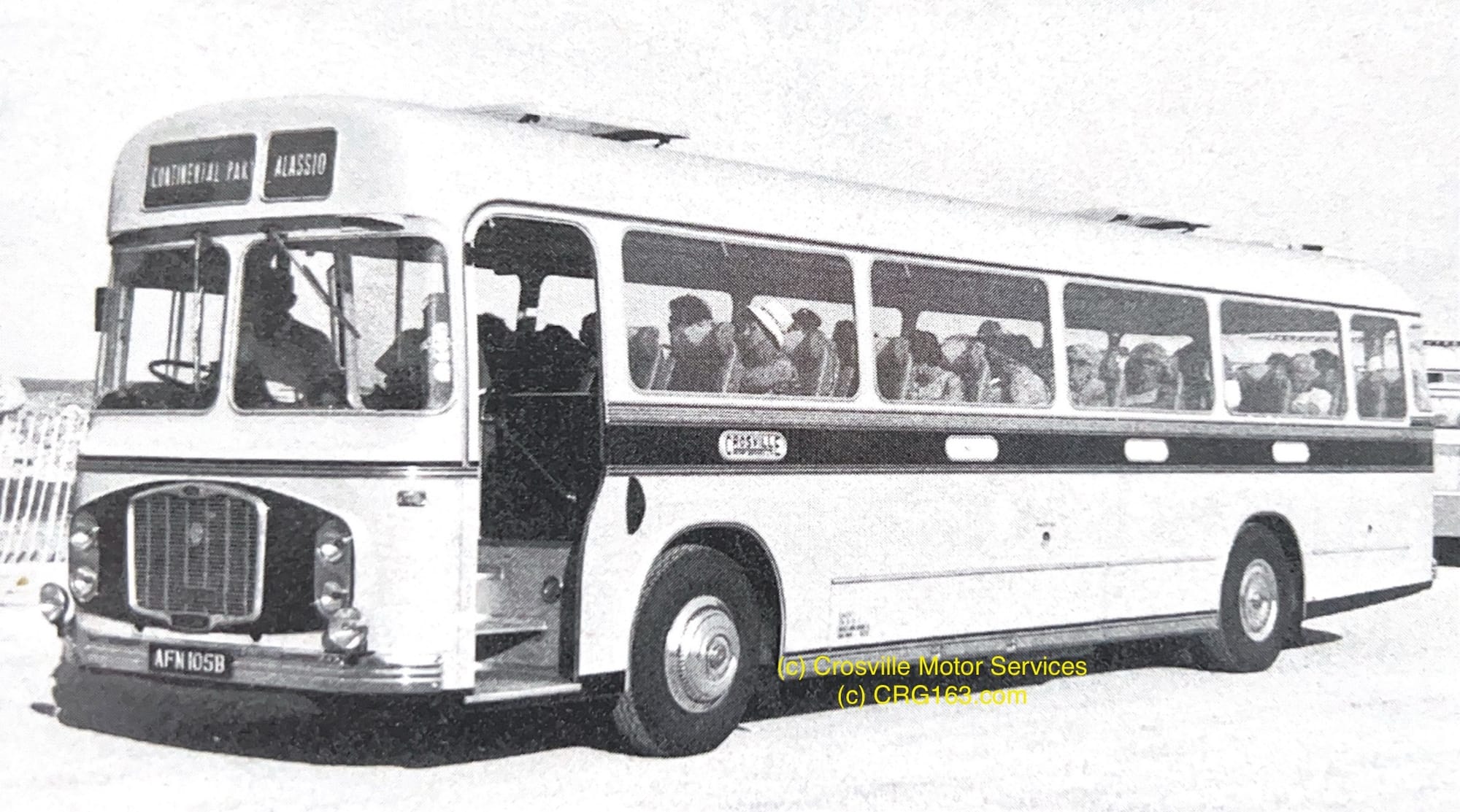 CRG530 - Italy - in house tour arranged by Stanley Hughes, North Wales Divisional Manager in 1964. One of a series of such journeys. The coach went as far as Alassio in Italy, returning via Monaco and included a special set of side panels.
CRG530 - Italy - in house tour arranged by Stanley Hughes, North Wales Divisional Manager in 1964. One of a series of such journeys. The coach went as far as Alassio in Italy, returning via Monaco and included a special set of side panels. CRG530 is seen here on the first inaugural journey of the Cymru Coastliner, introduced by Crosville on the 5th of September 1965 between Caernarfon and Chester under the L1. The vehicle still displays the AA badge on the front grille from its trip to Monaco whilst the side panels have now been changed to ‘Caernarvon - Chester - Limited Stop - Crosville’.
CRG530 is seen here on the first inaugural journey of the Cymru Coastliner, introduced by Crosville on the 5th of September 1965 between Caernarfon and Chester under the L1. The vehicle still displays the AA badge on the front grille from its trip to Monaco whilst the side panels have now been changed to ‘Caernarvon - Chester - Limited Stop - Crosville’. An official photograph by Crosville Motor Services Ltd of CRG496 sweeping majestically through Chester’s Eastgate Street en route from Liverpool to London on the prestigious X1 service on 22 July 1966.
An official photograph by Crosville Motor Services Ltd of CRG496 sweeping majestically through Chester’s Eastgate Street en route from Liverpool to London on the prestigious X1 service on 22 July 1966.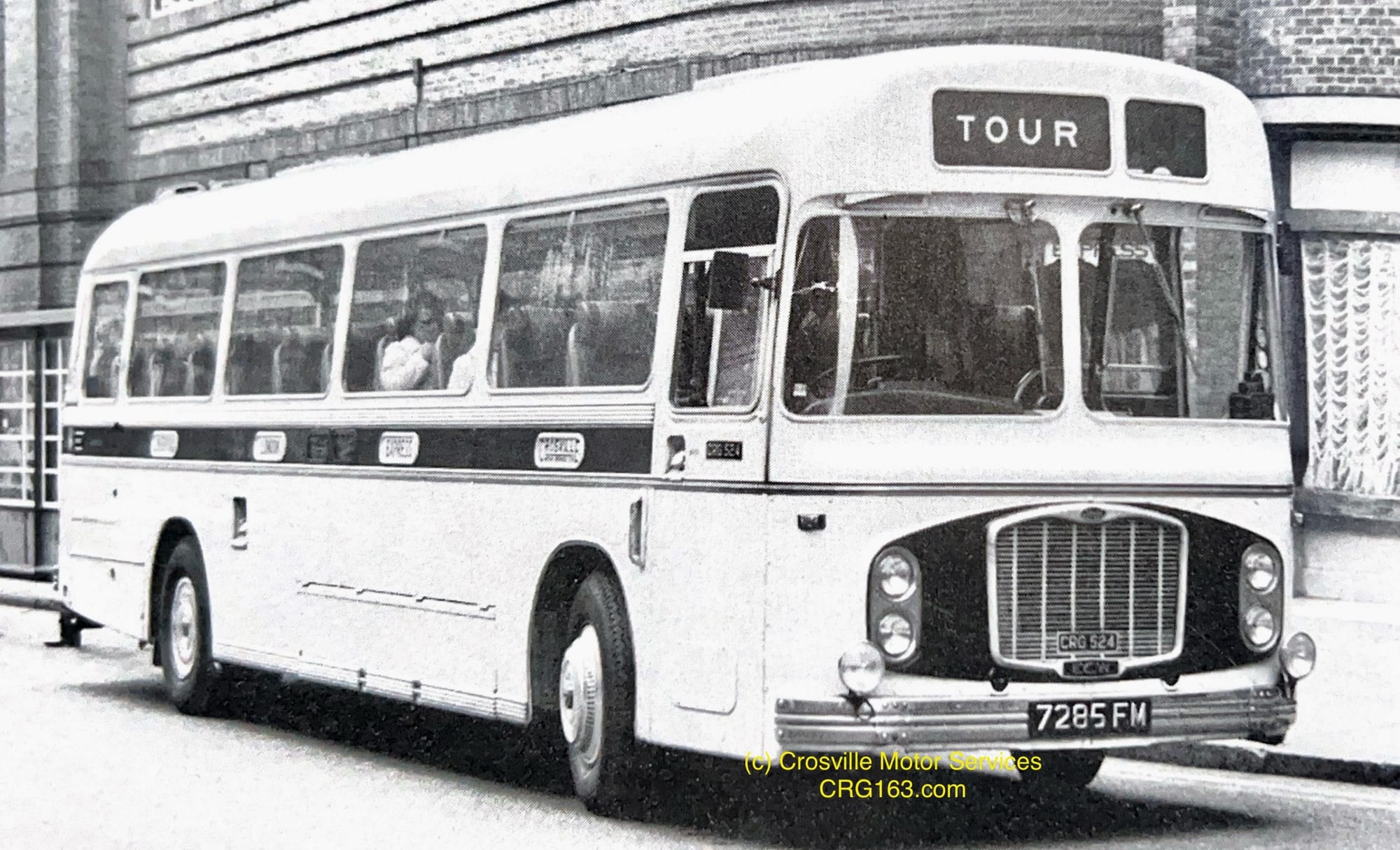 CRG524 seen here on a tour, pictured at the Odeon Cinema, Northgate Street Chester on 1st August 1968.
CRG524 seen here on a tour, pictured at the Odeon Cinema, Northgate Street Chester on 1st August 1968. Llandudno Junction flyover - 22 May, 1969. CRG526 crosses the new flyover on the 0625 Cymru Coastliner from Bangor to Chester. Driver A. Edwards, with Conductor I. R. Roberts is seen with Inspector Ifor Williams.
Llandudno Junction flyover - 22 May, 1969. CRG526 crosses the new flyover on the 0625 Cymru Coastliner from Bangor to Chester. Driver A. Edwards, with Conductor I. R. Roberts is seen with Inspector Ifor Williams.Crosville publicity
Within Crosville’s official publicity the CRG class would feature, not only through the above photographs but also included in posters and leaflets. Examples of this are shown below.



The last batch of 1970: CRG160 - CRG164
CRG163 was delivered new to Crosville Motor Services on 26 January 1970, and first registered on 6 March 1970.
CRG163 was one of five new and beautiful Bristol RELH coaches delivered to Crosville in 1970 and the final batch of this type of vehicle that the company would receive. The batch consisted of CRG160 (EFM160H) to CRG164 (EFM164H).
All in all 59 vehicles were delivered new to Crosville in 1970 of which five were coaches, that being CRG160 - CRG164.

When new all five coaches were allocated to Crosville’s Edge Lane depot in Liverpool, to operate the company’s prestigious long distance scheduled coach services between Liverpool and London.
The history of each vehicle has been pieced together. Whilst introduced to the company in 1970 they were all withdrawn from service by between 1981 and 1985. There is no information available about what happened to the batch beyond being withdrawn by Crosville CRG163. The Bristol Commercial Vehicles Enthusiasts website by Rob Sly notes that each one bar CRG163 was scrapped sadly.
It appears that ERG164 was withdrawn from service as early as June 1981 which was only 11 years since new in 1970. Was there a reason why the vehicle was withdrawn so early?
If you have any information about these five coaches, or additional photographs then please get in touch by e-mailing post@crg163.com .
Crosville confirms five new coaches: 1970
Crosville Motor Services provided a regular newsletter to its staff through a company magazine called Crosville United. This would be available in the form of a soft cover book format and include updates about staff and their families, depots, company community activities and vehicles. It would be customary to include any new vehicles that would be introduced to the fleet.
Our journey in relation to these five fine vehicles goes back to Crosville United, issue number 73 from January 1970. This would provide the initial information about the upcoming delivery of five new coaches to the company in the form of CRG160, CRG161, CRG162, CRG163 and CRG164 (EFM160H - EFM164H). The cover of this very magazine issue and relevant page informing the impending delivery of these vehicles is shown below.
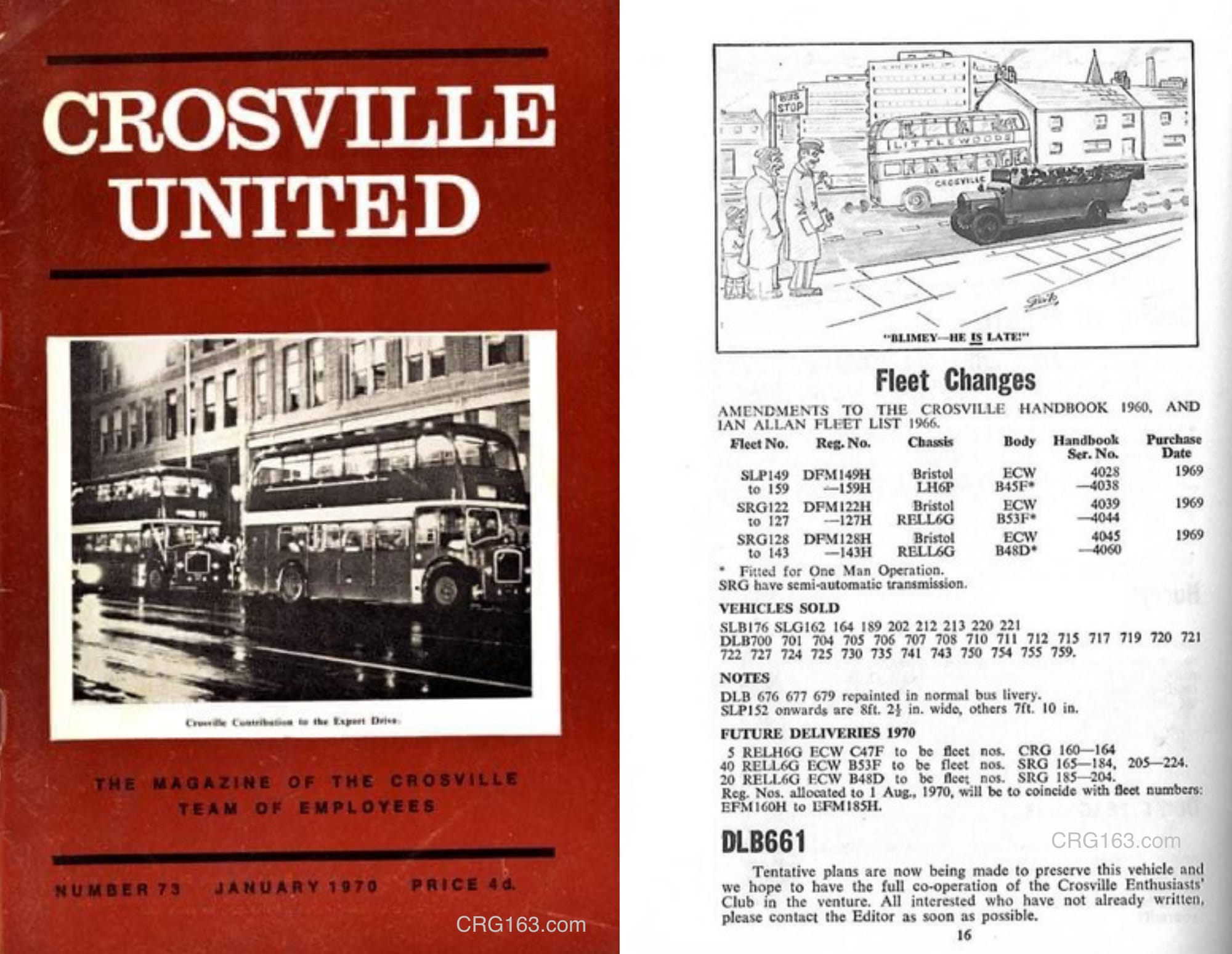
Crosville United issue number 73 from January 1970, noting the future delivery of CRG160 to CRG164 to the company.
In the Crosville United edition of Spring 1970 (below), the arrival of these magnificent vehicles was confirmed as having entered the fleet. This edition of the magazine was numbered 75 as printed, however this was a typing error and as such it was issue number 74 in reality.
The printed cover of this issue and corresponding page is shown below.

Crosville United issue number 75 in Spring 1970 confirming company fleet changes with the arrival of CRG160 to CRG164 amongst other new vehicles and disposals.
On entering service the five coaches quickly settled down to their new duties at Crosville’s Edge Lane depot of operating the company’s prestigious long distance scheduled coach services between Liverpool and London.
They arrived in the company’s beautiful and elegant cream and black coaching livery which included four centre side panels on the nearside and offside of each vehicle, lighting up at night, displaying ‘CROSVILLE - LIVERPOOL - LONDON - EXPRESS’. The Mark 1 coach was truly beautiful and special, complemented fully by the wonderful cream and black coaching livery.
This livery would unfortunately only last about twelve months, favouring a more simplistic version from around 1971, replacing the four side panels each side of each vehicle with one longer panel both sides above the front wheel arch with the name ‘Crosville’ displayed in lower type font.
During 1972 the Liverpool to London service was further strengthened with the introduction of the X18 service that would predominantly operate via the motorway. CRG162 was chosen as the first vehicle that would debut and operate this new service on the 1225 departure from Liverpool Edge Lane to London. The driver would be Mr J. Martin, with Mr L. Brereton, the depot’s District Traffic Superintendent wishing him well on his journey before he set off.
The story of CRG162 first journey on the X18 service was captured again in Crosville United, issue number 82 from Autumn 1972. The story from the magazine is shown below.

CRG162 becomes a bit of a star on the 9th of June 1972 as reported in the ‘Crosville United’ magazine issue number 82 - Autumn 1972. It becomes the first coach to operate the new X18 service from Liverpool to London, taking four and a half hours, commencing with the 1225 departure.
 A close up of driver J. Martin, with Mr L. Brereton, before leaving on the 1225 Liverpool to London X18 service on the 9th of June 1972.
A close up of driver J. Martin, with Mr L. Brereton, before leaving on the 1225 Liverpool to London X18 service on the 9th of June 1972.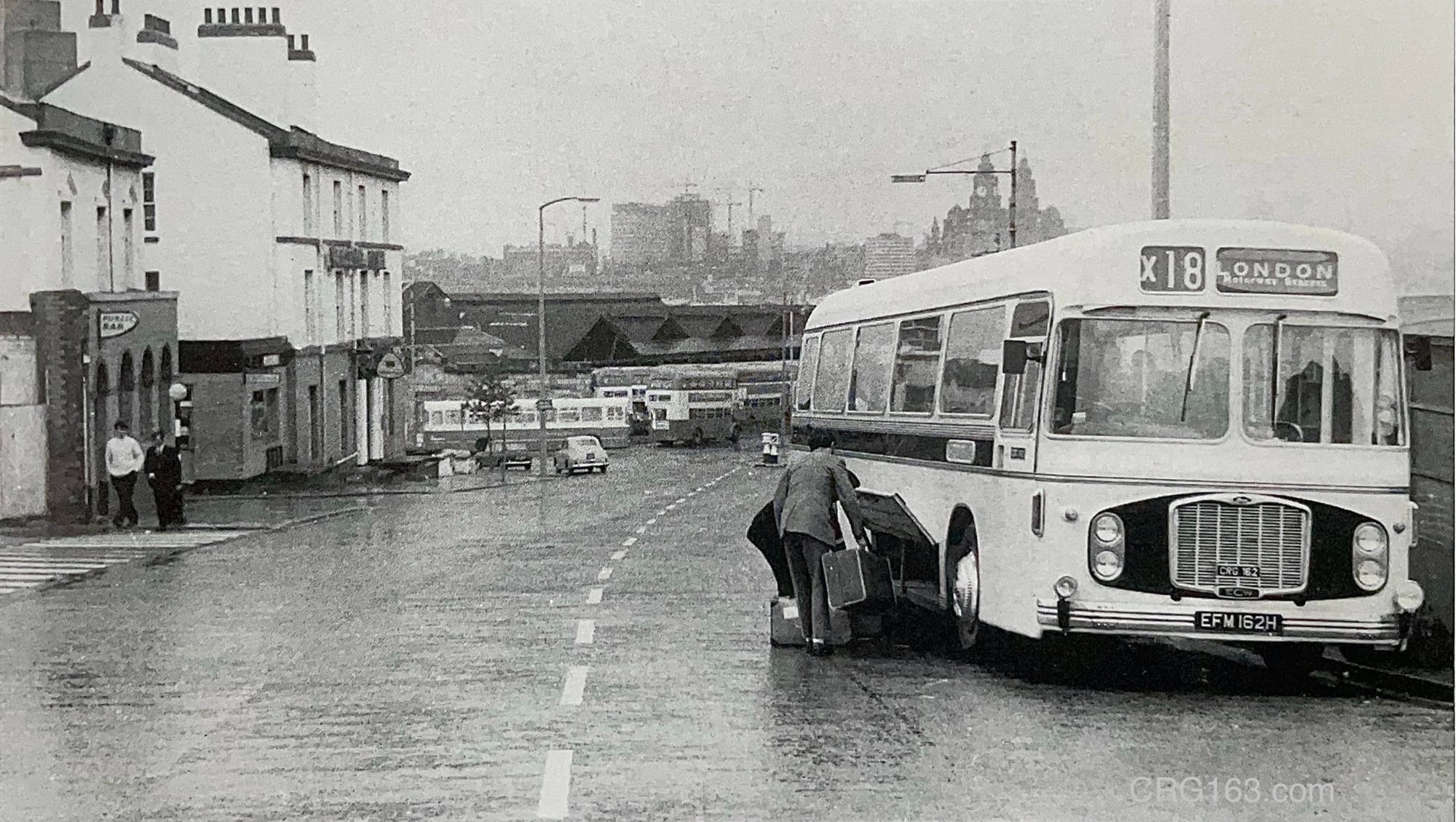 CRG162 loads up luggage at the Woodside coach stop, Birkenhead as it continues its first journey on the new X18 service on the 9th of June 1972.
CRG162 loads up luggage at the Woodside coach stop, Birkenhead as it continues its first journey on the new X18 service on the 9th of June 1972. Restored and preserved CRG163 is seen here recreating the above image of CRG162, thirty three years later in 2005.
Restored and preserved CRG163 is seen here recreating the above image of CRG162, thirty three years later in 2005.
CRG162 is seen here calling at Ellesmere Port Bus Station with driver J. Martin at the wheel on the first X18 journey to London on the 9th of June 1972.
The same year Crosville introduced the next generation of Bristol RELH coach in the form of the CRL fleet class (CRL259 - CRL268). This would be the Series 2, Mark 2 Bristol RELH/ECW coaches fitted with the more powerful and faster Leyland 0.680 engine. The performance of these vehicles in terms of speed would be better than the CRG class, thus reducing the end to end journey times between Liverpool and London, and be more attractive to the passenger. This resulted in CRG160 - CRG164 being redeployed on to other long distance services over time which would included North Wales and other destinations.
From 1972 onwards the scheduled coaching element of Crosville and all other National Bus Company (NBC) subsidiaries would also see further imposed changes of conformity and co-ordination through the introduction of the NATIONAL brand. This would bring about one identity for all long distance scheduled coach services under the NATIONAL white coach brand, washing away previous coaching liveries such as Crosville’s cream and black coach livery.
With the introduction of the NATIONAL brand CRG160 to CRG164 and all other coaches would quickly be repainted into the new all white livery.

Crosville Motor Services’ fleet list publication dating from 1974, listing CRG160 to CRG164 within the fleet. The same page also lists other CRG’s some of which have also survived to preservation, being CRG103, CRG106 and CRG111.
As the new CRL class of coach settled down on the Liverpool to London service, by the mid to late 1970’s, CRG160 - CRG164 would be redeployed to other depots across the company’s operational territory.
A vehicle policy of Crosville and other National Bus Companies was to downgrade vehicles of a certain age to dual purpose use, meaning that such vehicles were no longer restricted to longer distance scheduled coach services and private hire, but would now be operated on a host of services including local bus. Such vehicles would be fitted with a ticket machine and repainted into what would be called the dual purpose livery of green and white. The first letter of their fleet number would also be reclassified from ‘C’ for coach to ‘E’, signifying dual purpose use. In the case of CRG160 - CRG164 they succumbed to this process from late 1978 to late 1979, becoming ERG160 - ERG164 respectively.
Below is Crosville’s official fleet list from June 1979. CRG160 had become ERG160 by then; in the same way as CRG161 to ERG161. In August of the same year CRG164 had become ERG164 and in December CRG163 had become ERG163.
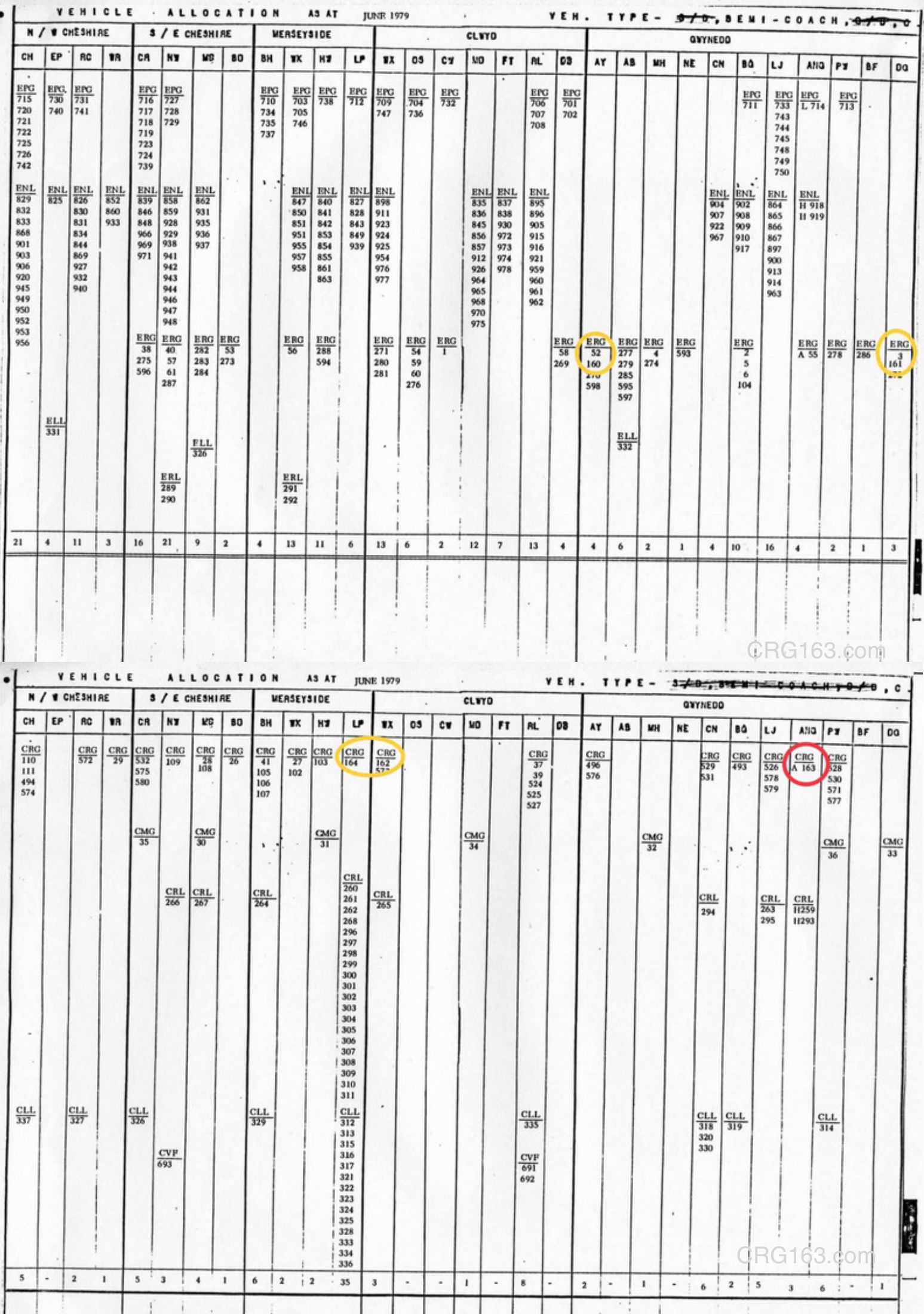
Crosville’s official fleet list of vehicles and depot allocations dating back to June 1979. From this fleet list CRG160 has been downgraded to ERG160, allocated to Aberystwyth depot (AY); CRG161 has also succumbed to downgrading and is ERG161 at Dolgellau depot (DG); CRG162 clings on to its coaching status at Wrecsam depot (WX); CRG163 also clings on to its coaching status, allocated to Anglesey (ANG), but more specifically to Amlwch depot (A); CRG164 also retains its coaching status and is allocated to Liverpool (LP) Edge Lane.
Below is Crosville’s official vehicle fleet list from 1 February 1981. Unfortunately it only provides details for Western company depots in Wales. Whilst ERG160, ERG161 and ERG163 are accounted, ERG162 is suspected to be based at Corwen depot and ERG164 suspected as being already withdrawn by the company.

This is Crosville’s official fleet list and depot allocation from 1 February, 1981. ERG160 continues to be allocated to the company’s Aberystwyth depot; ERG161 continues to be allocated to Dolgellau depot; CRG163 by now has also succumbed to dual purpose status as ERG163 and continues to be based at Crosville’s Amlwch depot. The fleet list copy above does not include any other operating area of the company which would include ERG162 and ERG164. At this time ERG162 is likely to be based at Corwen depot. However sadly it likely that ERG164 has already been withdrawn from active service, believed to be scrapped in June 1981.
What stands out from tracing the history of these vehicles is the fact that ERG164 seems to have been withdrawn by the company as early as June 1981. There is no information that confirms why the company withdrew this vehicle at this time when only over 11 years in actual service from new. What had become of ERG162? Had the vehicle been involved in an accident in someway which forced early withdrawal?
All of the five vehicles seem to have been withdrawn by Crosville between 1981 and 1985, a period of four years. However no information is available on what happened to these fine vehicles beyond withdrawal bar that of CRG163.
If you have any further information about these five vehicles, please get in touch by e-mailing post@crg163.com .
A summary of CRG160 - CRG164 in pictures
Below is a summary profile for each of the vehicles in this batch delivered to Crosville in 1970.
This is supported by fantastic images of the five vehicles as captured by camera back in the day.
Can I please take the opportunity to say how very lucky we are to have had photographers back in the day who took the time and trouble to document Crosville and these fantastic vehicles through the lens.
Below we have truly amazing photographs captured by a number of people on this page and dotted throughout this website. These photos have been kindly provided for reproduction on this website and specifically for this page by:
- John Buchan
- Mike Lambden
- John Lee
- Andrew Marks
- Keith Mason
- Stephen Monaghan
- Don McKeown
- Geoff O’Brien
- Graham Senior
- Geoff Smith
- Grahame Warehame
Thank you very, very much for being allowed to reproduce your wonderful photographs here.
Such people are photographic historians and we are indebted to these people with our grateful thanks. Having such images keeps Crosville, these vehicles and many others very much alive and vivid to us all and future generations. Thank you very, very much.

CRG160 (EFM 160H)
Vehicle profile
New: 02/1970
Initial fleet number: CRG160
Registration number: EFM160H
Chassis type: Bristol RELH6G
Chassis number: RELH-4/255
Body make: Eastern Coach Works (ECW)
Body number: 18137
Seating: C47F
Engine: Gardner 6HLX
Gearbox: Semi-auto
Year downgraded: 1978
Downgraded fleet number: ERG160
Depot allocations: Liverpool Edge Lane; Aberystwyth
Liveries carried: Cream & black coaching; simpler cream & black coaching; National white; dual purpose green and white including ‘De Cambria Crosville’ transfers
Year withdrawn from service: 02/1983
Life beyond Crosville: not known, believed to be scrapped

ERG160 is seen here inside Crosville’s Aberystwyth depot.

ERG160 is seen here at Aberystwyth with 701 Cardiff on its destination blind, flanked by Bristol LH SLL629.
 ERG160 is seen here leaving Crosville’s Machynlleth depot along Doll Street towards the centre of the town. The depot is just out of shot on the far left, before the BP garage.
ERG160 is seen here leaving Crosville’s Machynlleth depot along Doll Street towards the centre of the town. The depot is just out of shot on the far left, before the BP garage.CRG161 (EFM 161H)
Vehicle profile
New: 03/1970
Initial fleet number: CRG161
Registration number: EFM161H
Chassis type: Bristol RELH6G
Chassis number: RELH-4/256
Body make: Eastern Coach Works (ECW)
Body number: 18138
Seating: C47F
Engine: Gardner 6HLX
Gearbox: Semi-auto
Year downgraded: 1979
Downgraded fleet number: ERG161
Depot allocations: Liverpool Edge Lane; Dolgellau; Bangor
Liveries carried: Cream & black coaching; simpler cream & black coaching; National white; dual purpose green and white
Year withdrawn from service: 03/1983
Life beyond Crosville: not known, believed to be scrapped
 ERG161 is seen here on the Mann Island roundabout, Liverpool in June 1980. John Buchan recalls, “This photo was taken probably not long after its conversion to a dual purpose format. It still looked super though, and just had to be photographed!”
ERG161 is seen here on the Mann Island roundabout, Liverpool in June 1980. John Buchan recalls, “This photo was taken probably not long after its conversion to a dual purpose format. It still looked super though, and just had to be photographed!” A variety of Bristol RE’s at Crosville’s Bangor depot in the early 1980s. ERG274, SRG123 and ERG161. Photograph: Carl Richards.
A variety of Bristol RE’s at Crosville’s Bangor depot in the early 1980s. ERG274, SRG123 and ERG161. Photograph: Carl Richards.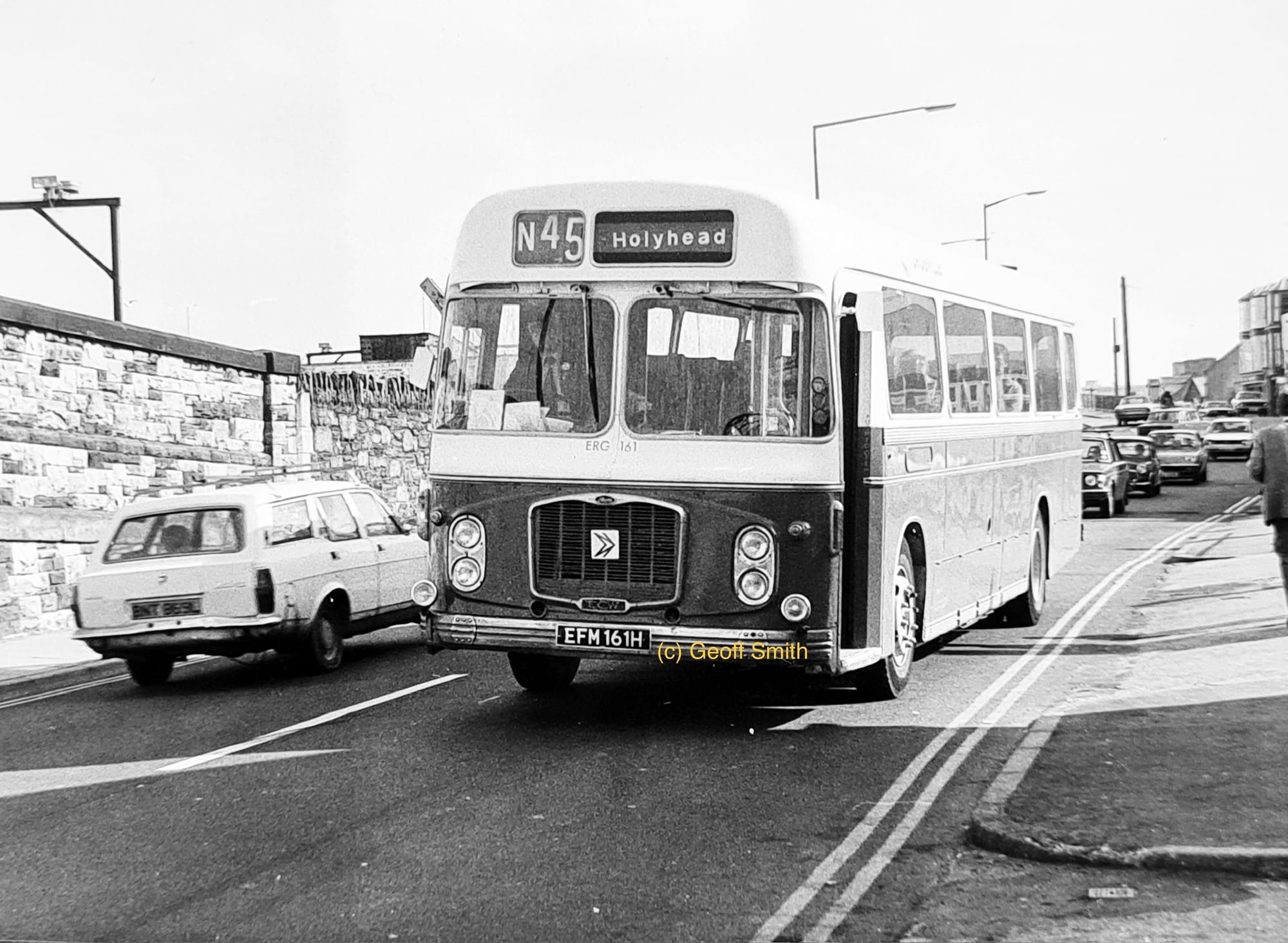 ERG161 can be seen arriving Holyhead on route N45.
ERG161 can be seen arriving Holyhead on route N45.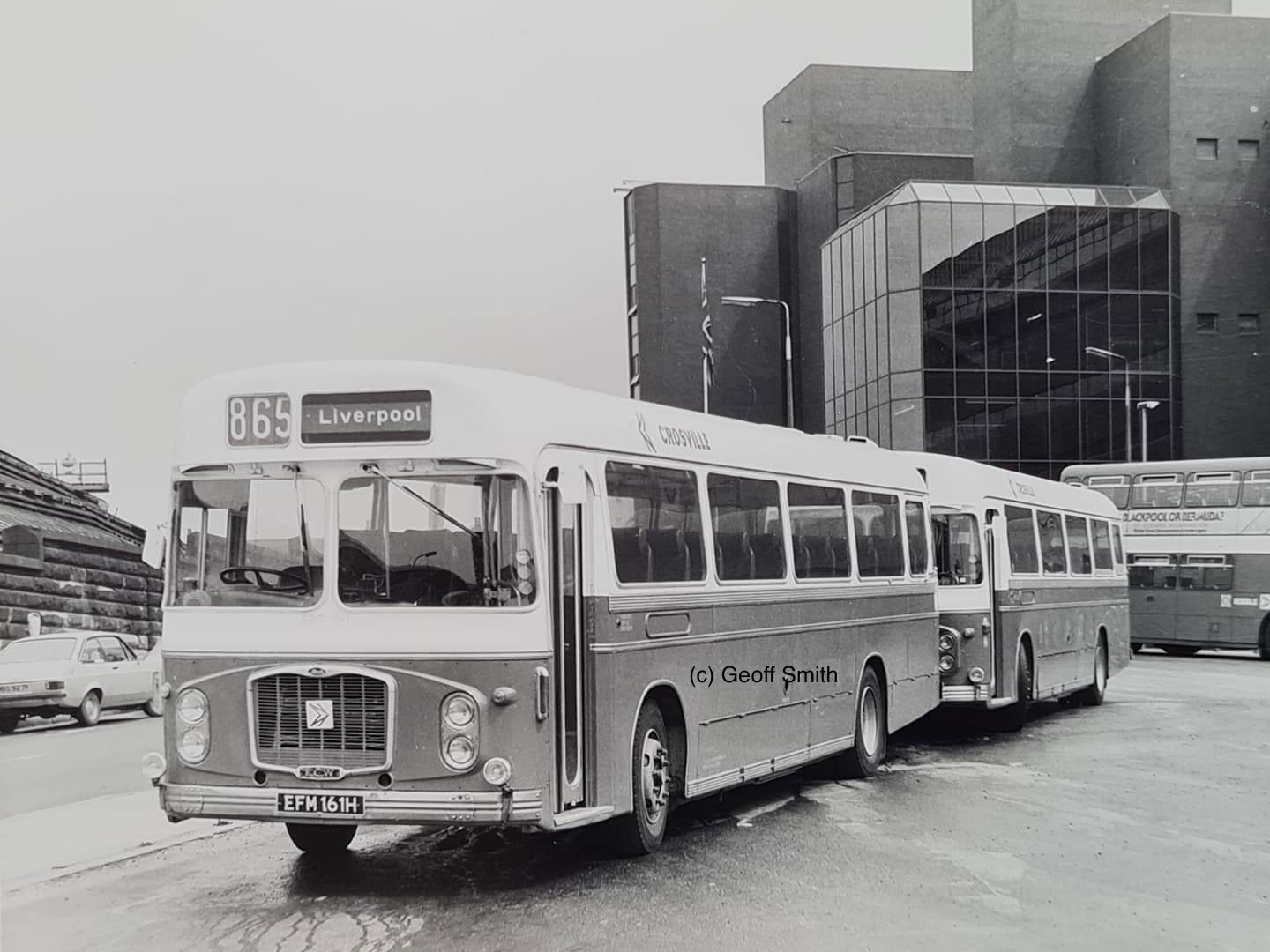 ERG161 is seen here parked in Liverpool with ERG163 parked behind minus its nearside front trafficator. Geoff comments ‘ERG161 at Skelhorne St with Copperas Hill sorting office in the background’. Geoff’s b&w photographs are absolutely amazing.
ERG161 is seen here parked in Liverpool with ERG163 parked behind minus its nearside front trafficator. Geoff comments ‘ERG161 at Skelhorne St with Copperas Hill sorting office in the background’. Geoff’s b&w photographs are absolutely amazing. 
ERG161 and ERG163 side by side outside Crosville’s Amlwch depot. ERG163 can also be seen sporting the Town Lynx branding.
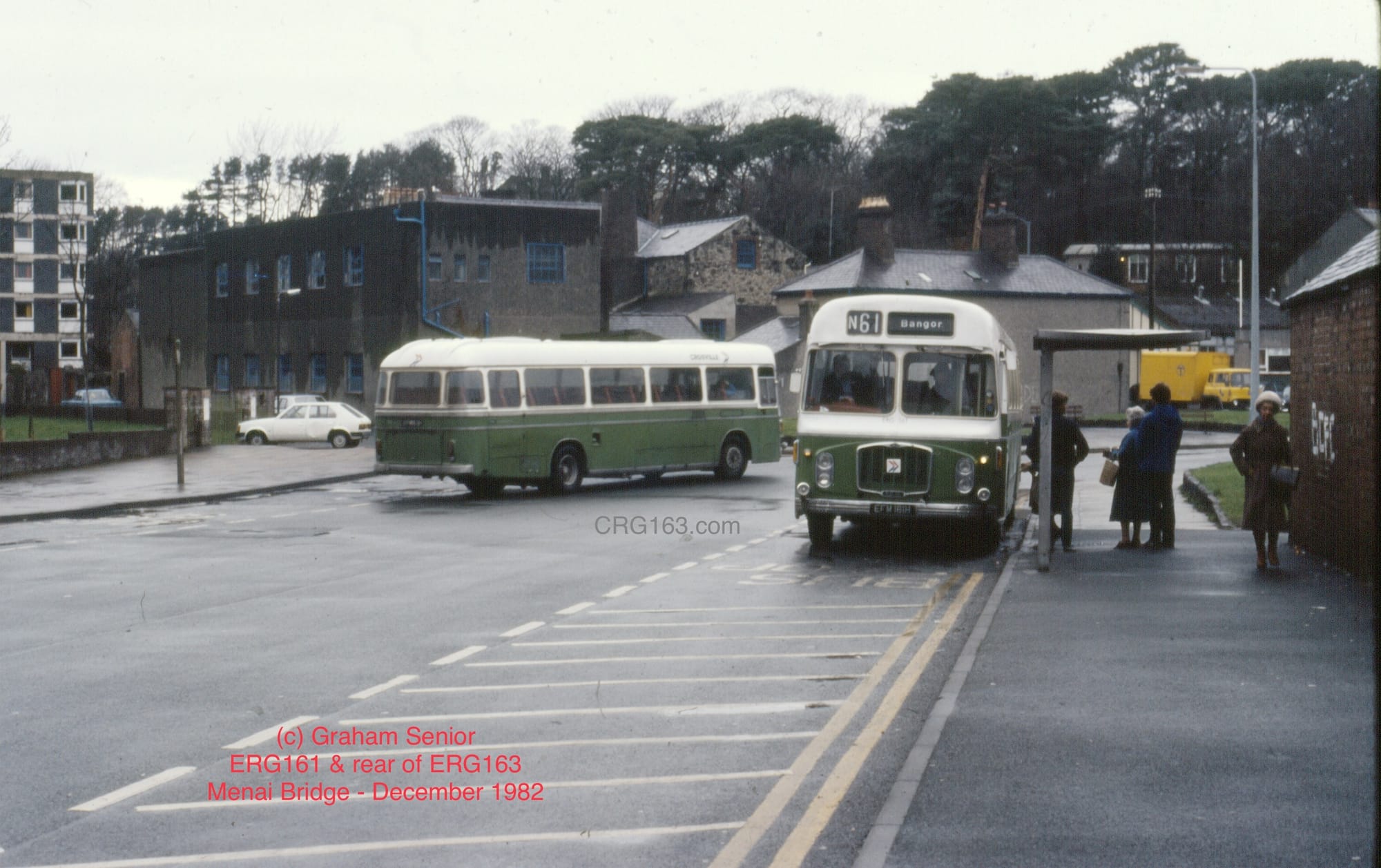
ERG161 at Menai Bridge, Bangor bound with ERG163 in the background.
CRG162 (EFM 162H)
Vehicle profile
New: 02/1970
Initial fleet number: CRG162
Registration number: EFM162H
Chassis type: Bristol RELH6G
Chassis number: RELH-4/257
Body make: Eastern Coach Works (ECW)
Body number: 18139
Seating: C47F
Engine: Gardner 6HLX
Gearbox: Semi-auto
Year downgraded: 1979
Downgraded fleet number: ERG162
Depot allocations: Liverpool Edge Lane; Wrecsam; Corwen
Liveries carried: Cream & black coaching; simpler cream & black coaching; National white; dual purpose green and white
Year withdrawn from service: 1985
Life beyond Crosville: not known, believed to be scrapped

CRG162 in it’s cream and black coaching livery parked up at Crosville’s Edge Lane depot on 23 May 1970. Photo kindly supplied with thanks from Mr John Lee.

CRG162 at Victoria Coach Station, London in 1970 having operated the X1 service from Liverpool, kindly allowed for reproduction by Mr Andrew Mark with thanks. Mike Lambden comments that he thinks that this is Mr Bob Parry at the wheel from Crosville’s Liverpool Edge Lane depot.

The biennial BICC staff outing for which Crosville supplied the coaches for many years was a major logistical exercise which was nevertheless very prestigious for the company. The view shows a selection of immaculately turned out coaches lined up on Manchester Road, Prescort, before moving off to various locations to commence their pick-ups. 9 CRG’s were provided from Liverpool Edge Lane depot. The exact vehicle details are unknown now but the impressive line up is being led by CRG162.

CRG162 alongside sister vehicle CRG163 at Stratford-Upon-Avon in 1973 on service X1, London bound. With many thanks to Mr John Buchan for the permission to share his photograph on our

CRG162 can be seen parked in Oxford on its long journey home to Liverpool on service X1.

ERG162 can be seen here in the paint shop.

ERG162 is seen here parked up at Corwen depot.

ERG162 can be seen here operating service D71 to Oswestry.

ERG162 is seen here on a private hire.
CRG163 (EFM 163H)
Vehicle profile
New: Delivered new on 26/01/1970, first registered on 06/03/1970
Initial fleet number: CRG163
Registration number: EFM162H
Chassis type: Bristol RELH6G
Chassis number: RELH-4/258
Body make: Eastern Coach Works (ECW)
Body number: 18140
Seating: C47F
Engine: Gardner 6HLX
Gearbox: Semi-auto
Year downgraded: 12/1979
Downgraded fleet number: ERG163
Depot allocations: Liverpool Edge Lane (1970-1979); Amlwch (1979-1984)
Liveries carried: Cream & black coaching; simpler cream & black coaching; National white; dual purpose green and white
Year withdrawn from service: 04/1984
Life beyond Crosville: Entered preservation with Gordon Bate (1984-2002) restored to second version of cream & black livery; Richard Lloyd Jones (2002 - onwards) restored to National white livery

CRG163 on the prestigious X1 service from Liverpool to London in its first cream and black coaching livery.

CRG163 is seen here having arrived Victoria Coach Station, London from Liverpool on service X1 in 1971. By now the second more simplest cream and black livery has been applied.
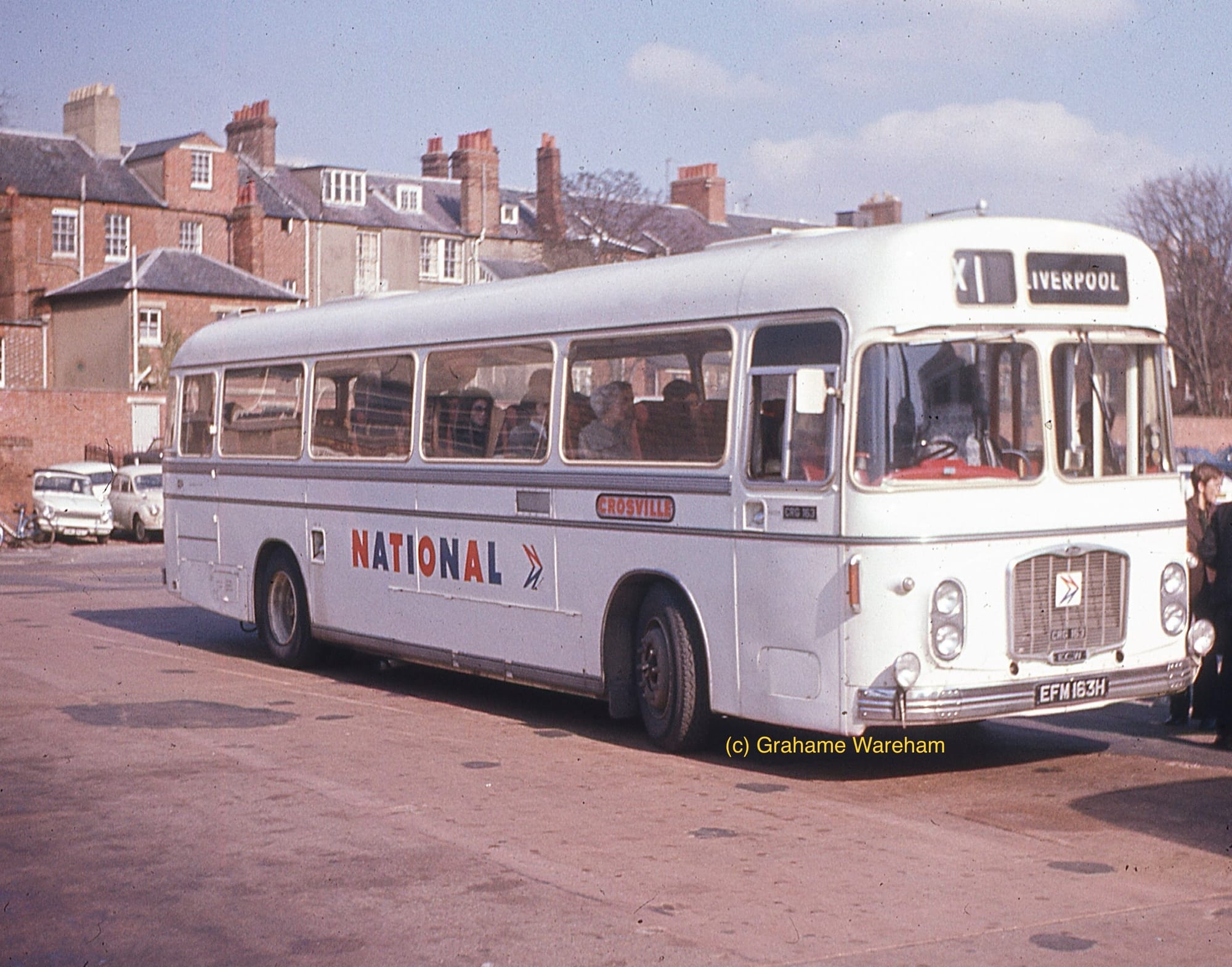
CRG163 has donned the corporate National white livery as it is seen at Gloucester Green, Oxford - April 1973.

CRG163 on service 853, returning home to Liverpool. Photograph courtesy of Geoff Smith.
 CRG163 on the 855 service between 1977 and 1979, seen here at Coventry with the side panel showing Crosville above the front nearside wheel arch illuminated.
CRG163 on the 855 service between 1977 and 1979, seen here at Coventry with the side panel showing Crosville above the front nearside wheel arch illuminated.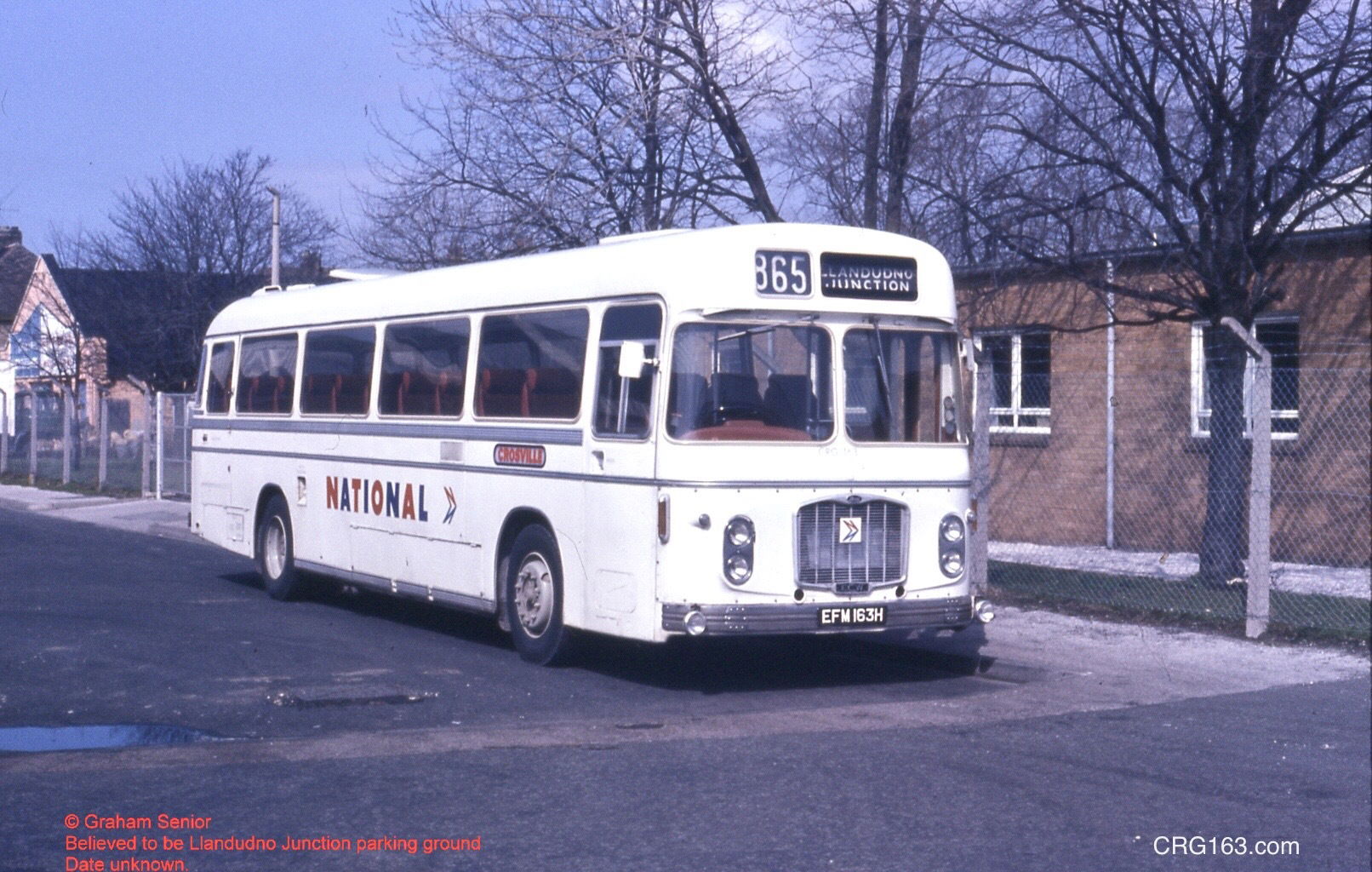
CRG163 parked at Llandudno Junction having operated the 865 from Liverpool.

A black and white image of ERG163 parked at Liverpool Skelhorne Street opposite Lime Street, likely to have operated the X10 service from Cemaes Bay. The vehicle parked ahead of ERG163 in this image is ERG161. A different angle can be seen above under CRG161’s entry. Photograph courtesy of Geoff Smith.
 A row of Crosville coaches parked at Delamere Street bus and coach station, Chester in the early 1980’s. ERG163 is parked on stand 14, operating the X10 service between Cemaes Bay and Liverpool, flanked by ERL527 on the right and ELL30 far right.
A row of Crosville coaches parked at Delamere Street bus and coach station, Chester in the early 1980’s. ERG163 is parked on stand 14, operating the X10 service between Cemaes Bay and Liverpool, flanked by ERL527 on the right and ELL30 far right. 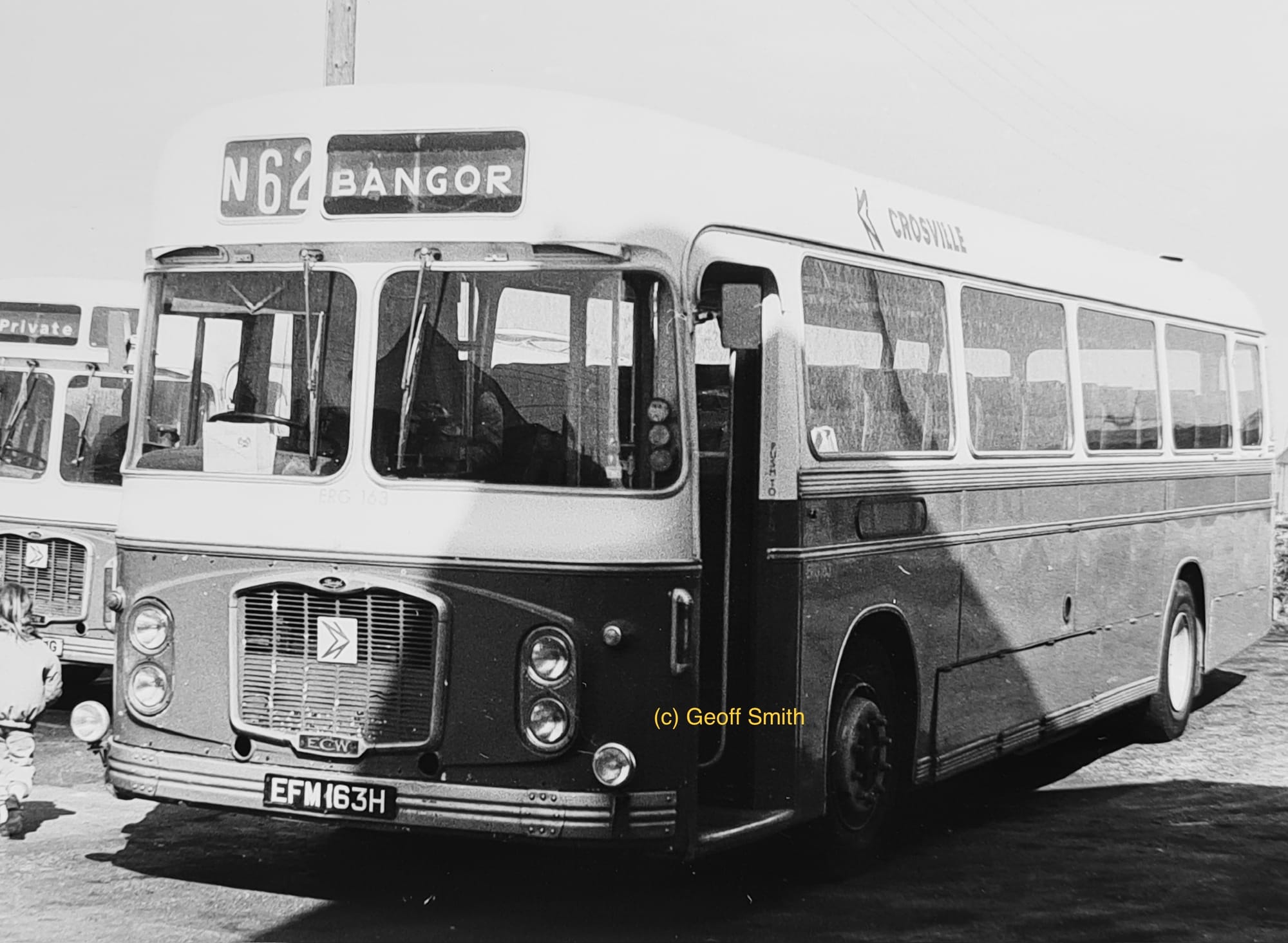
ERG163 parked outside Crosville’s Amlwch depot. Photograph courtesy of Geoff Smith.

ERG110 and ERG163 parked outside Crosville’s Amlwch depot. An atmospheric image made through its black and white appearance of both vehicles. Photograph courtesy of Geoff Smith.

Photo kindly provided by Graham Senior. The image is of ERG110 and ERG163 at Crosville’s Amlwch depot - 17 April 1982. It’s so interesting to capture the story behind the image. Graham comments:
This photo was taken on a glorious Saturday 17 April 1982, and the reason for the presence of ERG110 was that she had been hired by "The Crosville Enthusiasts' Club (1967)", for a depot trip (originating at Chester) encompassing Llanrwst, Bangor and the three Anglesey depots. As Max Boyce would have said, "I know, 'cos I was there!". Seeing the pictures on your splendid website brought back the happy memory, and I've dug out my (very similar) shot of the occasion, to that of Geoff Smith which was filed under ERG110.

ERG163 can be seen here resting at the Bangor Clock Bus Station having operated service N62 from Cemaes Bay and Amlwch. DOG118 can be seen on the left making its way to the Holyhead bus stand around the corner for route N44.

ERG163 leaving Amlwch, Bangor bound on the N62 with Richard Lewis, Amlwch depot behind the wheel. Photo courtesy of Don McKeown.

Eventually ERG163 succumbed to withdrawal from service in April 1984. It’s future was very much uncertain as it waited its fate on the Crosville disposal line at the company’s Sealand Road Works (SRW) at Chester.

Preserved CRG163 is seen here under the ownership of Gordon Bate, who purchased the vehicle directly from Crosville in 1984. By now the vehicle had been returned to it’s second cream and black coaching livery from 1971, bar the red Crosville fleet name the vehicle would have carried from 1972 to 1979. Gordon’n tenure of CRG163 would last from 1984 to 2002.

Here preserved CRG163 can be seen again circa 2004/2005 in a show on Anglesey with the late Derek Thompson sitting behind the wheel. By now CRG163 is owned by Richard Lloyd Jones, having purchased the coach from Gordon Bate on 9 June 2002 for further restoration and preservation.
CRG164 (EFM 164H)
Vehicle profile
New: 02/1970
Initial fleet number: CRG164
Registration number: EFM164H
Chassis type: Bristol RELH6G
Chassis number: RELH-4/259
Body make: Eastern Coach Works (ECW)
Body number: 18141
Seating: C47F
Engine: Gardner 6HLX
Gearbox: Semi-auto
Year downgraded: 08/1979
Downgraded fleet number: ERG164
Depot allocations: Liverpool Edge Lane (1970-1979); Warrington (1979); Denbigh (1980); Runcorn (1980)
Liveries carried: Cream & black coaching; simpler cream & black coaching; National white; dual purpose green and white
Year withdrawn from service: 06/1981
Life beyond Crosville: not known, believed to be scrapped

CRG164 is seen here in National white livery, parked at the rear of Crosville’s Edge Lane depot, Liverpool with Pensarn Street seen in the background. From the vehicle’s destination it seems that has operated the 850 motorway service from London.

CRG164 can be seen here parked at London’s Victoria Coach Station as it prepares to operate its return journey to Liverpool on service 853. To the right of CRG164, Royal Blue 2361 (841 SUO) having operated service 700 to London.
The surviving Crosville CRG (Bristol RELH) coaches are in date order of build: CRG530, CRG573, CRG103, CRG106, CRG111, CRG163 (6 in total from 47 original)
New Crosville in Liverpool book
A new book on the history of Crosville in Liverpool will be available from 15 July 2025 onwards. For further details and to pre-order please click HERE or visit the following web address.

Contact details
If you have any photos or related information about CRG163 or sister vehicles then please e-mail us at post@crg163.com . Many thanks in advance.
Please note
There are some photos on this website where copyright is unknown. If these photos are yours then please let me know by e-mailing post@crg163.com so that they can either be removed immediately or copyrighted to your name accordingly. Thank you.
All photographs have been watermarked on this website and should not be reproduced elsewhere without prior consent. Unfortunately some private photos previously shared on line have been copied without permission and have subsequently appeared for sale by third parties on e-bay.
Subscription
You can also subscribe to this website by entering your e-mail address into the white box below, bottom right and click the subscription button ⬇️
